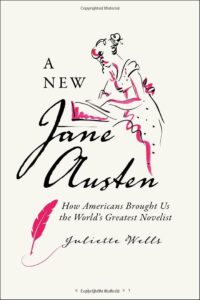
How American Critics Originated Jane Austen Scholarship
On the Birth of Austen Criticism
The first glimpse of a new, American approach to Austen appeared without fanfare in the reference volume A Brief Handbook of English Authors (1883/4), compiled by Oscar Fay Adams (1855–1919). In its entirety, Adams’s entry for Austen reads:
Austen, Jane. 1775–1817. Novelist. Author of Pride and Prejudice, Sense and Sensibility, Northanger Abbey, Mansfield Park, Persuasion, Emma, The Watsons, and Lady Susan. These novels are examples of the finest literary art, and have delighted cultured minds for almost three generations. Her character-drawing is strong and realistic. See Atlantic Monthly, Feb. 1863. See Jane Austen and Her Works by Sarah Tytler (pub. 1881). Pub. Har. Por. Lit. Rou.
Adams’s expertise in Austen is evident in his lists of both primary and secondary works. Her uncompleted, manuscript novels The Watsons and Lady Susan had just been published in America in 1882. Up to date too was Tytler’s Jane Austen and Her Works, the first book on Austen by a fellow woman writer: the Scottish novelist Henrietta Keddie, writing under a pseudonym. Though less current, Adams’s inclusion of the February 1863 Atlantic Monthly article is a telling choice as well. Rather than recommending one of the many recent periodical pieces on Austen, Adams instead reached back two decades to Mrs. R. C. Waterston’s essay “Jane Austen,” a heartfelt appreciation that incorporated details from Waterston’s correspondence with and visit to Austen’s oldest surviving brother, Admiral Sir Francis W. Austen.
Who was this Oscar Fay Adams, who united knowledge about Austen with enthusiasm? When A Brief Handbook of English Authors, his first book, was released, Adams was supporting himself as a schoolteacher in Erie, Pennsylvania, while beginning to publish short fiction and poetry in periodicals. Born in Worcester, Massachusetts, in 1855, Adams was educated as a teacher at the New Jersey State Normal School, now The College of New Jersey: a far cry from prestigious universities such as Harvard, at which George Pellew wrote his doctoral dissertation on Austen in 1883, the same year that Adams was finishing his Handbook. Later in the 1880s, Adams moved to Cambridge, Massachusetts, where he made the acquaintance of authors and scholars more distinguished than himself, many of whom were featured in the same “Literary Boston” article from which this chapter’s frontispiece portrait of him is reprinted. He joined the Boston Authors Club, which was founded in 1886, served for many years as the organization’s secretary, and bequeathed a selection of his literary manuscripts to the Club upon his death in 1919. Included in that bequest was Adams’s prized possession: a 1796 Austen letter given to him by the author’s great-nephew, Edward, Lord Brabourne.
Few documents concerning the genesis of Adams’s writings on Austen have survived, and still fewer that shed light on his life. In 1928, his sister, Emma L. Adams, presented to the American Antiquarian Society his scrapbook of newspaper clippings and a folder of letters received by him. These never-before-consulted archival materials illuminate the reception of Adams’s critical edition of Austen, Chapters from Jane Austen (1888/9), as well as the preparation and reception of his biography, The Story of Jane Austen’s Life (1891, 1896/7). That Adams, who never married, sought and found emotional intimacy with men is suggested by a series of twelve candid letters that he wrote to the poet and biographer George Edward Woodberry. Certainly, Adams’s respectful treatment in his biography of Austen’s status as a single woman indicates that he was not hemmed in by conventional thinking about gender or marriage.
As Austen’s first critical editor, in Chapters from Jane Austen, and her first critical biographer, in The Story of Jane Austen’s Life, Adams inaugurated the discipline of Austen scholarship. What’s more, he wrote informatively and clearly about Austen’s novels and life, and he went to great lengths to include contemporary photographs of Austen-related sites in the second edition of his biography. By doing so, Adams encouraged and equipped a new generation of readers, including but not limited to Americans, to cultivate their own appreciation of Austen’s works. Thus Adams stands too as the founder of what we would now call public humanities writing on Austen. All these extraordinary contributions he made with the credential only of his teaching degree, and without any academic affiliation at all.
*
The significance of Adams’s Chapters from Jane Austen, which was published by Lee and Shepard of Boston, has been entirely overlooked. Of this pioneering edition of Austen for American readers, the bibliographer David Gilson comments only that “[t]he editor gives for each novel a list of characters and the text of selected chapters, with connecting summary.” In fact, Adams acted as Austen’s earliest critical editor. He collated published versions of her novels in order to present an accurate text. He synthesized existing criticism on Austen in his forty-page Introduction and listed his sources in the first-ever bibliography of works on Austen. Finally, Adams created thoughtful explanatory footnotes for Austen’s novels intended especially for American readers.
As Austen’s first critical editor, in Chapters from Jane Austen, and her first critical biographer, in The Story of Jane Austen’s Life, Adams inaugurated the discipline of Austen scholarship.
The disregard for Chapters from Jane Austen doubtless stems in large part from its packaging and marketing as a book for children. Its title page proclaims that the volume is part of the “Cambridge Series of English Classics.” According to WorldCat, only one other book appeared in this series: Readings from the Waverly Novels (1889), which presented “Sir Walter Scott for young people edited for school and home use by Albert Blaisdell, A. M.” Blaisdell, the author of several textbooks on literature and health, stated in his Preface that he aimed to “foster a taste for good literature” among “pupils in our schools.” He did not annotate his chosen excerpts from Scott’s novels, judging that “[t]he selections speak for themselves.”
Adams’s Preface to Chapters from Jane Austen makes plain that he envisioned a very different audience and purpose for his volume than did Blaisdell. “The student of literature needs no introduction to Jane Austen,” Adams declares, since:
he has long since learned to know and to admire her. But to the general reader hers is not the familiar name one could wish it to be; or, if familiar, it is only as a name, it is to be feared. The purpose of the present volume is to supply such information concerning Miss Austen and her works as shall enable the ordinary reader to feel that he knows at least more of her than her name, and is in a position to form for himself an intelligent appreciation of her genius.
In other words, Adams designed Chapters from Jane Austen not for schoolchildren but for a “general” and “ordinary” reader who has a mind of his [sic] own—and who might well be prejudiced against Austen. Pragmatically, Adams acknowledges that some might use Chapters from Jane Austen only to gain “the satisfaction of knowing who Jane Austen was, and what she accomplished.” He expresses his hope, however, that many more “may be led to examine the novels in their entirety.”
In keeping with his goal of helping each reader “form for himself an intelligent appreciation” of Austen, Adams presents Austen’s six novels in the order of their composition, as then understood: Pride and Prejudice, Sense and Sensibility, Northanger Abbey, Mansfield Park, Emma, and Persuasion. He precedes each excerpt from a novel with the work’s dates of writing, revision, and publication. Furthermore, Adams presents extensive excerpts from commentary on Austen’s novels. He states that he has chosen his “introductory matter . . . from the mass of material relating to Jane Austen, mainly with a view to present what was freshest and unhackneyed; and, in the cases of Mrs. Thackeray-Ritchie and Miss Keddie, with the purpose also of showing the estimate placed upon Miss Austen by novelists of her own sex.” Well beyond mere suggestions for further reading, which Blaisdell provided for Scott’s novels, Adams supplied what he termed a “partial bibliography.” He included therein full citations for J. E. Austen- Leigh’s A Memoir of Jane Austen (1870, 1871), Lord Brabourne’s 1884 edition of Austen’s letters, Tytler’s Jane Austen and Her Works, and Pellew’s Jane Austen’s Novels, plus briefer citations for several dozen reviews and articles from British and American periodicals (365–6).
Both Adams’s selections from criticism and his bibliography were groundbreaking. True, J. E. Austen-Leigh had assembled praise for Austen’s works in his Memoir, even adding “Opinion of American readers” to his second edition, as I noted in Reading Austen in America. In a biography by a proud family member addressed primarily to an English audience, however, such passages serve a very different function than they do in Adams’s introduction to Austen’s novels for American readers. By carefully sifting through observations on Austen and preparing a detailed bibliography, Adams enabled not only enjoyment of Austen’s works but also serious study of them.
__________________________________

Excerpted from A New Jane Austen: How Americans Brought Us the World’s Greatest Novelist by Juliette Wells. Copyright (c) 2023 Bloomsbury. Used by arrangement with the Publisher. All rights reserved.
Juliette Wells
Juliette Wells, Professor of Literary Studies at Goucher College (USA), is the author of two acclaimed books about Jane Austen’s historic readers and fans: Reading Austen in America (2017) and Everybody’s Jane: Austen in the Popular Imagination (2011). For Penguin Classics, she edited Austen’s Persuasion (2017) and Emma (2015).



















